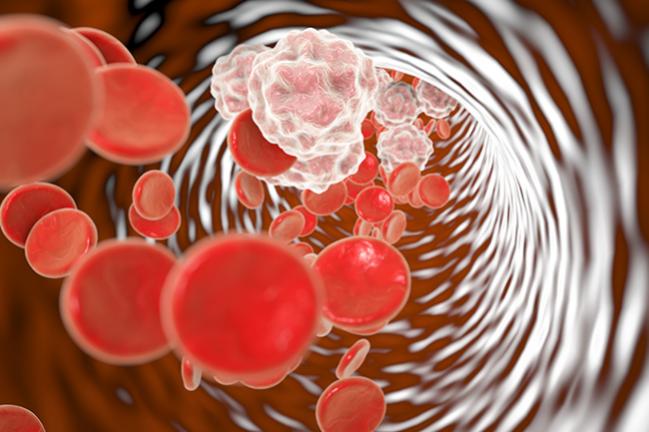Elevated High-Sensitivity CRP Lingers Long After MI, Observational Study Shows
Intensive statins or anti-inflammatory agents may be useful in these patients, but studies must first establish hsCRP as a risk marker—and target.

High-sensitivity C-reactive protein (hsCRP) levels remain elevated in patients several years after an MI, yet standard cardiovascular risk factors account for only about one-fifth of the variability in measurements of this biomarker, according to new registry data.
“This higher prevalence of hsCRP elevation in the prior MI population, along with the apparent independence of the distribution from other cardiovascular risk factors, lend some support to the hypothesis that inflammation may lie in the causal pathway of vascular disease,” write study authors led by Neha Pagidipati, MD, MPH (Duke Clinical Research Institute, Durham, NC). “If inflammation does indeed lie in the causal pathway of cardiovascular disease, then the high prevalence of inflammation in individuals with prior MI, as is evidenced in this study, is of public health concern.”
For their study, published online, July 26, 2018, ahead of print in the American Heart Journal, the researchers looked at 1,296 individuals with a prior MI with hsCRP information from the NHANES database between 1999 and 2010, representing about 6.3 million people or 3.5% of the US population. Patients were on average 7.1 years out from their MI. The mean and median hsCRP levels in the population were 5.84 mg/L and 2.69 mg/L, respectively, and about 61% had levels ≥ 2 mg/L.
On multivariate analysis, BMI was the strongest predictor of hsCRP (P < 0.001), and accounted for 11.3% of the variation in the hsCRP levels. Increasing non-HDL cholesterol, increasing age, decreasing HDL, smoking, female sex, hypertension, and absence of hyperlipidemia also were associated with higher hsCRP.
Just 22% of the variation in hsCRP levels in the NHANES population could be explained by the traditional cardiovascular risk factors included in the study. Moreover, among the patients with elevated hsCRP, 9% did not have any of the standard modifiable risk factors.
Doubling Down on Who Needs Treatment
To TCTMD, Pagidipati expressed surprise at how common elevated hsCRP was in this population and how little CVD risk factors accounted for the variance. As for the public health implications, she noted that prior studies have shown that elevated hsCRP in patients with prior MI is associated with worse outcomes.
“The fact that 61% of patients with prior MI in this sample had an hsCRP level ≥ 2 mg/L may indicate that a large proportion of this population is at particularly high risk for adverse outcomes,” she said in an email.
Speaking with TCTMD, Stephen Ellis, MD (Cleveland Clinic, OH), said this study “suggests that maybe there's a population here that might benefit from treatment, either [with] statins, as shown in JUPITER, or other anti-inflammatories as shown in CANTOS. Elevated CRP is certainly, I think, related to the extent and severity and probably acuity of coronary disease, so I'm not surprised to see it's somewhat elevated.”
He also stressed that these prior MI patients should already be taking a high-dose statin. “So the question is: what else can we do for them?” he said. “But I think it's just sort of putting a stake in the ground and saying, ‘Look, there's a lot of these folks out there. Maybe there's additional treatments for them.’”
Ellis said research needs to show that hsCRP is predictive of outcomes in this specific patient population, although he’d be surprised if it wasn’t. “And then since they should be on statins anyway, if they're prognosis is really not very good at all, then they could potentially be intervened upon by medications specifically targeting inflammation,” he said.
Going forward, Pagidipati said she would like to see “more prospective randomized controlled trials to determine whether decreasing systemic inflammation leads to improved outcomes, both in patients with known cardiovascular disease and in those at high risk of CVD.”
As for the broader applicability of the findings, she suspects the results would likely be similar in a population of non-US post-MI patients, although that has not been tested. “But I believe that the biological processes underpinning elevated hsCRP level in patients with a prior MI are likely to be similar around the world, though environmental and some genetic influences would clearly be different,” said Pagidipati.
Yael L. Maxwell is Senior Medical Journalist for TCTMD and Section Editor of TCTMD's Fellows Forum. She served as the inaugural…
Read Full BioSources
Pagidipati NJ, Hellkamp AS, Sharma PP, et al. High-sensitivity c-reactive protein elevation in patients with prior myocardial infarction in the United States. Am Heart J. 2018;Epub ahead of print.
Disclosures
- Pagidipati reports holding ownership in Freedom Health, Physician Partners, RXAdvance, and Florida Medical Partners.
- Ellis reports no relevant conflicts of interest.


Comments